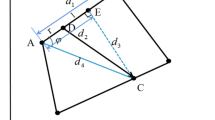Abstract
Ocean bottom node (OBN) data acquisition is the main development direction of marine seismic exploration; it is widely promoted, especially in shallow sea environments. However, the OBN receivers may move several times because they are easily affected by tides, currents, and other factors in the shallow sea environment during long-term acquisition. If uncorrected, then the imaging quality of subsequent processing will be affected. The conventional secondary positioning does not consider the case of multiple movements of the receivers, and the accuracy of secondary positioning is insufficient. The first arrival wave of OBN seismic data in shallow ocean mainly comprises refracted waves. In this study, a nonlinear model is established in accordance with the propagation mechanism of a refracted wave and its relationship with the time interval curve to realize the accurate location of multiple receiver movements. In addition, the Levenberg-Marquart algorithm is used to reduce the influence of the first arrival pickup error and to automatically detect the receiver movements, identifying the accurate dynamic relocation of the receivers. The simulation and field data show that the proposed method can realize the dynamic location of multiple receiver movements, thereby improving the accuracy of seismic imaging and achieving high practical value.
Similar content being viewed by others
References
Di, Z. P., Tong, S. Y, and Sun, C. X., 2016. Second positioning of the vertical cable based on automatic grid searching surface fitting method with first break. National Security Geophysics Professional Committee of Chinese Geophysical Society, Military Geophysics Professional Committee of Shaanxi Provincial Geophysical Society, 2016: 203206.
Fan, J., and Pan, J., 2006. Convergence properties of a self-adaptive Levenberg-Marquardt algorithm under local error bound condition. Computational Optimization and Applications, 34 (1): 47–62, DOI: https://doi.org/10.1007/s10589-005-3074-z.
Gao, Y., Fan, Z. C., Wang, M., and Wu, X. D., 2008. Application research on geophone re-location technology by refraction wave method. Geophysical Prospecting for Petroleum, 47 (3): 285–289 (in Chinese with English abstract).
Ge, X. D., 2015. A study on the second positioning technique for the first break in OBC seismic exploration of shallow sea. Master thesis. Ocean University of China.
He, X. M., 2015. Research on the data processing for the receiver points acoustics positioning in the offshore seismic surveying. Master thesis. China University of Petroleum (East China).
Huang, L. Z., 2011. The secondary positioning of receiver based on wave equation. Offshore Oil, 31 (2): 34–38 (in Chinese with English abstract).
Liu, Y. L., Cai, X. L., and Lu, Y. M., 2017. Technology and application of upstream and downstream wave separation of OBN data. Geophysical Exploration Professional Committee of Chinese Petroleum Society, 2017: 4952.
Luo, Y. Y., Bian, H. Z., Liu, Q. Z., Liu, B. Q., Fu, Z. C., Zhang, J. X., et al., 2022. An improved TDOA lightning location approach considering L-M algorithm and acoustics. Journal of Shanghai Jiao Tong University, 56 (3): 353–360, DOI: https://doi.org/10.16183/j.cnki.jsjtu.2020.301 (in Chinese with English abstract).
Ma, L., Li, Q. C., and Ma, J. Q., 2023. OBN secondary positioning method jointly by first breaks of direct and refracted waves in shallow water based on dynamic penalty weighting. Oil Geophysical Prospecting, 58 (1): 75–82, DOI: https://doi.org/10.13810/j.cnki.issn.1000-7210.2023.01.007 (in Chinese with English abstract).
Ni, C. Z., Quan, H. Y., Chen, G., and Liu, H. X., 2008. A new method of high-precision first break secondary positioning-search method. Oil Geophysical Prospecting, 43 (2): 131–133, DOI: https://doi.org/10.13810/j.cnki.issn.1000-7210.2008.02.003 (in Chinese with English abstract).
Wang, Q., 2018. Levenberg-Marquardt method for solving nonlinear equations. Master thesis. China University of Mining and Technology.
Wang, Z. C., Zhou, H. W., Tong, S. Y., Fang, Y. F., and Cao, G. B., 2020. Secondary positioning of deep ocean bottom nodes. Oil Geophysical Prospecting, 55 (2): 242–247, DOI: https://doi.org/10.13810/j.cnki.issn.1000-7210.2020.02.002 (in Chinese with English abstract).
Xu, C., 2020. Research on underwater secondary positioning for ocean bottom node (OBN) with seismic wave. Master thesis. Chang’an University.
Xu, K. B., Chen, Z. B., Liu, Y. H., Ren, Y. Q., Bai, T. Z., and Ran, L. G., 2018. A microseismic localization method based on L-M inversion algorithm. Oil Geophysical Prospecting, 53 (4): 765–769, DOI: https://doi.org/10.13810/j.cnki.issn.1000-7210.2018.04.013 (in Chinese with English abstract).
Yang, H. C., Liu, H. S., Tong, S. Y., and Zhang, S. G., 2004. Application of acoustic secondary positioning technology to high-precision seismic acquisition of KD-1 area. Marine Geology Letters, 20 (4): 33–36, DOI: https://doi.org/10.16028/j.1009-2722.2004.04.006.
Yang, H. S., Xu, L. J., Ma, J., Hou, K. P., and **ao, Y. X., 2021. First-break positioning and accuracy evaluation based on vector superposition. Oil Geophysical Prospecting, 56 (1): 49–56, DOI: https://doi.org/10.13810/j.cnki.issn.1000-7210.2021.01.005 (in Chinese with English abstract).
Yang, Z. H., and Zhang, H. J., 2013. An approximate tetrahedron method for the secondary positioning in OBC seismic survey. Oil Geophysical Prospecting, 48 (2): 163–170, DOI: https://doi.org/10.13810/j.cnki.issn.1000-7210.2013.02.001 (in Chinese with English abstract).
Zhang, Z. Y., 2005. The receiver secondary location using refraction wave method. Journal of Southwest Petroleum Institute, 27 (2): 22–24 (in Chinese with English abstract).
Zhu, Q., Li, S. K., and Xu, Z., 2016. Study of solving nonlinear least squares under large residual based on Levenberg-Marquardt algorithm. China Measurement & Test, 42 (3): 12–16, DOI: https://doi.org/10.11857/j.issn.1674-5124.2016.03.003.
Acknowledgements
This research is funded by the National Natural Science Foundation of China (No. 42074140), and the Scientific Research and Technology Development Project of China National Petroleum Corporation (No. 2021ZG02). At the same time, we would like to thank the GeoEast Processing System provided by BGP for its support of this study.
Author information
Authors and Affiliations
Corresponding author
Rights and permissions
About this article
Cite this article
Tong, S., Li, J., Xu, X. et al. Dynamic Location Method for Shallow Ocean Bottom Nodes Using the Levenberg-Marquart Algorithm. J. Ocean Univ. China 23, 953–960 (2024). https://doi.org/10.1007/s11802-024-5653-6
Received:
Revised:
Accepted:
Published:
Issue Date:
DOI: https://doi.org/10.1007/s11802-024-5653-6




